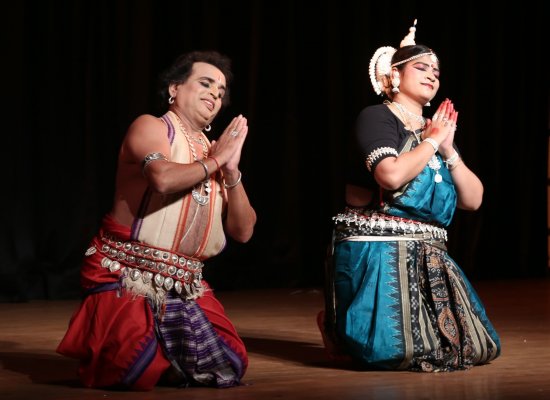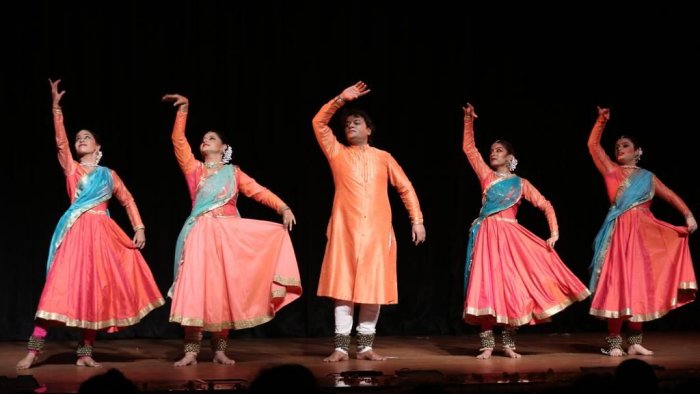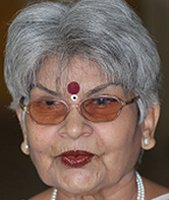
|   |

|   |
The 16th Guru Debaprasad Nrutya Parampara Festival - Manjari Sinha e-mail: manjari@sinha.com October 25, 2023 Debadhara, the Odissi institute of Guru Binayak Panda, presented its 16th Guru Debaprasad Nrutya Parampara Festival on 7th and 8th October 2023 at the Godavari Auditorium celebrating 20 years of their dedicated service towards artistic excellence in teaching, performing and propagating the art form. Established in Delhi by Guru Binayak Panda in 2003, Debadhara has strived ever since to promote and propagate the rich cultural heritage of India especially the unique Odissi dance style of Late Guru Debaprasad Das and the tribal and folk dance forms of Odisha.  Kala Shakti Group The festival showcased a mesmerizing array of performances, paying tribute to the late Guru Debaprasad Das, one of the founders of Odissi. The invocatory 'Pancha Deva Stuti' on the inaugural evening by the Kala Shakti Group trained under Guru Binayak Panda, underlined Debadhara's initiative to create an inclusive environment with empowering children through engagement in different art forms, on the behest of Pranjal Patil Lahensingh, Additional Director, Education who believes in making arts accessible to all. Day one of the festival featured captivating dance performances in Odissi by Dr. Gajendra Panda and his disciple Bagmishree Das, a Manipuri duet by Y. Theba Devi and Kheersana Yumlembam, Bharatanatyam by Dakshina Vaidyanathan Baghel and Rama Vaidyanathan, and Kathak by Abhimanyu Lal and his students.  Guru Gajendra Panda and Bagmishree 'Navarasa' presented by Guru Gajendra Panda and his disciple Bagmishree effectively brought out the rasa bhava of the nine moods or emotional states of human beings through short episodes from Ramayana. The melodious aalap in raga Desh on violin created the romantic aura of shringar when Guru Gajendra Panda emoted the 'Rasa Raja', the king of Rasas, shringar, through the first encounter between Rama and Sita, plucking flowers for Gauri Puja in anticipation of an ideal life partner or Pati. The romantic visage of Gajendra Panda turned into the enchanted Rama, enamoured by Sita's beauty. The veer rasa was convincingly depicted by Bagmishree through the Dhanurbhanga episode, where she enacted the valour of not just Rama who broke the Shiva Dhanush but also the kings who went to try it. Likewise, karuna, adbhuta, hasya, bibhatsa, raudra and shanta rasas were emoted alternately by the Guru and his able disciple. The selection of ragas like Shivaranjani for karuna, Malkauns for adbhutam ending with Bhairavi, was also commendable.  Theba Devi and Kheersana Yumlembam Manipuri dance by Y. Theba Devi and Kheersana Yumlembam brought out the Bhakti rasa of the Rasaleela in their lyrical performance of 'Radha Krishna Nartan'. Preceded with Radha Abhisara, it showcased the eternal love between Radha and Krishna, where Krishna plays his divine flute and the enchanted Radha comes following its mesmerizing swaras. Gradually both of them get involved in the ecstasy of 'Nartanam', dancing together. The authentic Manipuri music, despite being recorded, created the divine atmosphere of Basanta rasa.  Dakshina and Rama Vaidyanathan Offering their performance as a tribute to Late Guru Saroja Vaidyanathan, Rama Vaidyanathan, a leading exponent of Bharatanatyam originally trained under the legendary Yamini Krishnamurthy, and her gifted daughter / disciple Dakshina Vaidyanathan Baghel, gave an exquisitely engaging Bharatanatyam recital showcasing their mastery over the dance form, unique thought process and an entirely fresh approach to dance rooted in tradition. Dakshina opened with Nartana Ganesha (the dancing Ganesha), reminiscing how on a Ganesh Chaturthi that coincided with her Guru Saroja Vaidyanathan's birthday, Ganesh Yagyam was organized at Ganesha Natyalaya where the priests reciting Vedic chants from the Rig Veda made her decide that she would present it in dance. Dancing to the Vedic chants of the Rig Veda mantra, "Tat Purushaaya Ganapataye ..... tanno prachodayaat" recited in the musical background of the tuneful strains of taanpura, her depiction of the typical gait of Lambodara Ganesha, and learning dance under his father and Guru Shiva, with electrifying jatis mesmerized the audiences. Rama portrayed the delicate dilemma of the mother-daughter relationship with great sensitivity through poignant poetry from the 2nd/3rd century Sangam era. It was about the mixed feelings of a doting mother who sees her grownup daughter romancing with a young man. First shocked and perturbed she remembers all the love, affection, and care with which she has reared this child and brought her up and now she is no longer attached to her but loves someone else and then realizes that she should set her free from the clutches of her own affection and let her fly where she wants. Consoling herself for this, she thinks of and cites three analogies. The first one is that of the sandalwood tree which can't spread its fragrance unless its bark is separated. The second one is that of a pearl which cannot shine with its glow unless it is let out of the oyster shell, the mother pearl, and lastly, the swaras/music of veena, which cannot be released or heard unless the string of the veena is plucked. She realizes that her daughter also needs to be separated like the bark of the sandalwood tree, like a pearl from the oyster, and like a swara released from the string. Ultimately she hugs her daughter and happily lets her go! The performance opens with the melodious aalap in Bageshri on the violin when Dakshina is seen romancing with her young man holding her in his arms and kissing her. Rama sees this and feels emotionally upset with the thought of how lovingly she has brought up this daughter and now she loves some other person. The poem for the three episodes is composed in three appropriate ragas, the first one in Shyam Kalyan, the second one in raga Tilang, and the concluding one in Bhairavi. The captivating choreography climaxed with the happy ending duet resuming the same sweet sounding Bageshri the composition had opened with. The sprightly duet also incorporated 'Kanduka Kreeda' where they are playing the game of ball running after each other and a 'sawal-jawab' sequence of rhythmic Gopuchchh Tihai gradually reducing from a long aavartan to shorter ones ultimately hitting the 'sam' with a frozen pose of the awesome-twosome.  Abhimanyu Lal and group The finale of the inaugural evening came with a scintillating group performance by Abhimanyu Lal and his students Varsha Dasgupta, Shubhanshi Jain, Harpriya Dang, and Rakhi. Opening with 'Shiva Ananta,' a Dhrupad set to chautala in raga Jhinjhoti invoking Shiva, the power of infinity danced by Abhimanyu himself with emphatic Parans, Kavitta, and rhythmic compositions echoing in crisp footwork while the students depicted his attributes in "Jata joot, Neel kanth, Mahadeva", the Ganga flowing from his locks, snakes adorning his blue neck with drinking the poison et al adjoined with the Shiva Tandava Stotra danced by all of them together. Next came the segment of Shuddha Nritya in teen taal as a superb solo by Abhimanyu Lal with Upaj, Thaat, and Uthaan. Tode-Tukde, Paran, Chakkardar and Tihai etc which was joined later by Varsha Das as a duet. One only wished the lehera on flute was more tuneful than lacking behind the exact shruti. The captivating Kathak by Abhimanyu Lal and the group concluded with the famous Darbari Tarana danced with beauty and grace climaxing with fascinating footwork. All the musical compositions were composed by Guru Geetanjali Lal and choreographed by Abhimanyu Lal.  Debadhara ensemble The second evening of the two-day festival commenced with an Odissi dance recital by the students of Debadhara presenting compositions like 'Than Thei' in the signature style of Guru Debaprasad Das. The highlight of their performance was 'Durga Tandav,' as a tribute to Devi Durga. The grand finale came with the vocal recital by the 'Bhajan-Samrat' Pt. Anup Jalota, who regaled the audience with his choicest bhajans, ghazals, geet and film songs.  Manjari Sinha has an M.A. in Sanskrit and Music, and trained in vocal, tabla, sitar and Kathak dance. She has regular columns in national dailies as a music and dance critic. |